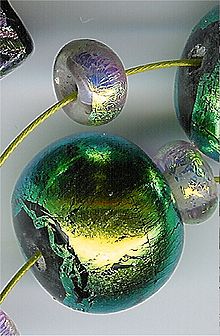- Dichroism
-
- Dichroic redirects here. For the filter, see dichroic filter. For the glass, see dichroic glass.
 Lampworked dichroic glass bead
Lampworked dichroic glass bead
Dichroism has two related but distinct meanings in optics. A dichroic material is either one which causes visible light to be split up into distinct beams of different wavelengths (colours) (not to be confused with dispersion), or one in which light rays having different polarizations are absorbed by different amounts.[1]
The original meaning of dichroic, from the Greek dikhroos, two-coloured, refers to any optical device which can split a beam of light into two beams with differing wavelengths. Such devices include mirrors and filters, usually treated with optical coatings, which are designed to reflect light over a certain range of wavelengths, and transmit light which is outside that range. An example is the dichroic prism, used in some camcorders, which uses several coatings to split light into red, green and blue components for recording on separate CCD arrays, however it is now more common to have a Bayer filter to filter individual pixels on a single CCD array. This kind of dichroic device does not usually depend on the polarization of the light. The term dichromatic is also used in this sense.
The second meaning of dichroic refers to a material in which light in different polarization states travelling through it experience a varying absorption. The term came about because of early observations of the effect in crystals such as tourmaline. In these crystals, the strength of the dichroic effect varies strongly with the wavelength of the light, making them appear to have different colours when viewed with light having differing polarizations. This is more generally referred to as pleochroism, and the technique can be used in mineralogy to identify minerals. In some materials, such as herapathite (iodoquinine sulfate) or Polaroid sheets, the effect is not strongly dependent on wavelength, and so the term dichroic is something of a misnomer, but still used.
Optically active molecules exhibit differing absorption to light of opposite circular polarization. This is known as circular dichroism.
Which meaning of dichroic is intended can usually be inferred from the context. A mirror, filter, or beam splitter is referred to as dichroic in the colour-separating first sense; a dichroic crystal or material refers to the polarization-absorbing second sense.
Dichroism in liquid crystals
Dichroism occurs in liquid crystals due to either the optical anisotropy of the molecular structure or the presence of impurities or the presence of dichroic dyes. The latter is also called a guest–host effect.[2] [3]
References
- ^ University Physics 6th Ed. F.W. Sears, M.W. Zemansky, H.D. Young ISBN 02101071991
- ^ Stephen M. Kelly (2000). Flat Panel Displays: Advanced Organic Materials. Royal Society of Chemistry. p. 110. ISBN 0854045678. http://books.google.com/books?visbn=0854045678&id=LMW0gofBH7sC&pg=PA110&lpg=PA110&dq=%22guest+host+effect%22#PPA109,M1.
- ^ dichroic glass resources
See also
Categories:
Wikimedia Foundation. 2010.
